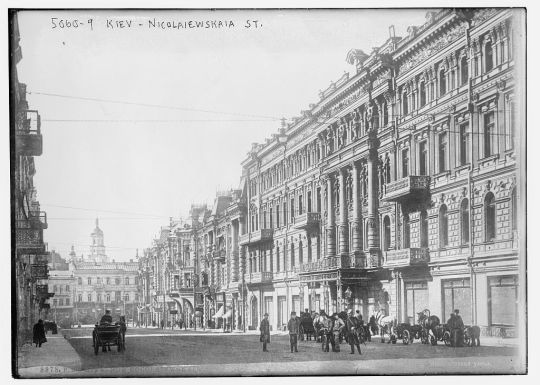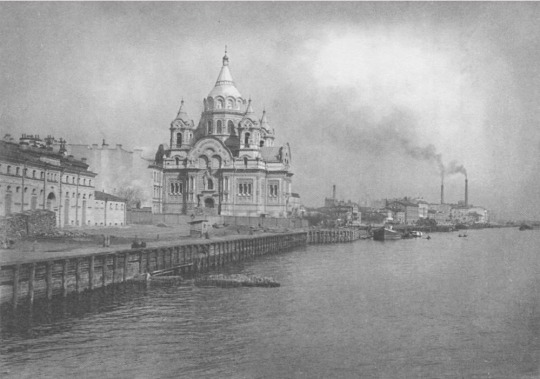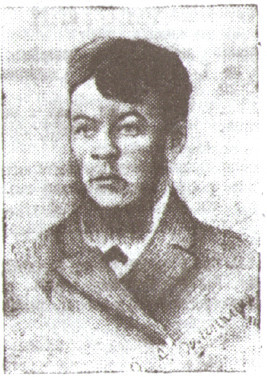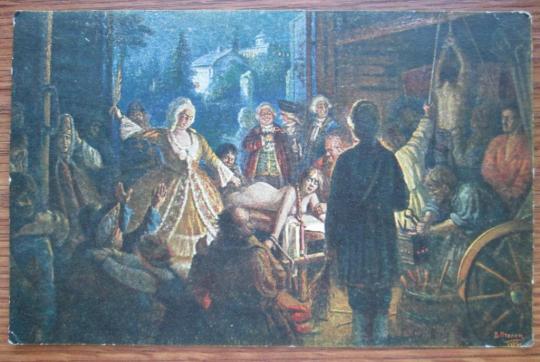Text
The Beilis Trial- A Story of Antisemitism

On March 20th 1911 the body of a 12-year-old boy was discovered in a small cave in the Lukyanovskaya suburb of Kiev. The body had 47 stab wounds made by a stitching awl, a special tool used for making holes in thick materials, such as leather.
The boy’s name was Andrei Yushchinsky, and what should have been a thorough criminal investigation uncovering local gang activities, turned into a shameful prosecution of Menahem Mendel Beilis, an innocent Jewish man, fueled by the antisemitic movement and political instability of the Russian Empire at the time.
Let us set the stage for this story, by diving into some important historical events, which facilitated the social unrest in the nation.
Firstly, “Krepostnoe Pravo” was the ownership or serfdom of peasants, which existed in the Empire since 14 hundreds, the times of Kievan Rus`. Unlike slavery in the West, serfdom meant that the people were attached to a certain piece of land, and could only be sold along with that land. Attempts to abolish it began in 1790s, but it took a lot of efforts and enlightenment to finally get rid of the inhumane rule in 1861 by Tsar Alexander II.

(Tsar Alexander Nikolaevich II. Years of reign 1855-1881)
While it is fair to mention, that a lot of nobility were supportive of the reform, we cannot ignore the resistance from others, far less enthusiastic dwellers of the wealthy social layers.
Another important factor in the game were the religious and cultural differences with the Jewish people, whose population increased tremendously after Russian Empire acquired new territories through the division of Polish-Lithuanian Commonwealth. The Jewish community constantly faced hardships and discrimination. “Pogroms”, the ultra-violent attacks on whole Jewish neighborhoods were terrible massacres, with no prosecution.

Finally, the growing revolutionary movement created secret societies and terrorist groups, who either supported the monarchy or wished to overturn it, both in their own violent ways.
This dangerous cocktail would be the cause of many sad and unfair acts against innocent people, and it would play the main role in the Beilis Trial.
Let us return to the sad story of the 12-year-old Andrei, who grew up without much affection or care from his single mother. His neighbours & classmates would often see him wonder the streets alone in the late hours. Despite the obvious neglect, he was considered a smart & well-behaved child, perhaps a little quiet and distant at times. He studied in the Theological School at St. Sophia Cathedral, hoping to become a priest which was his chance to escape his miserable life.

(The only photos that exist of Andrei, are those from his funeral)
When Andrei’s body was discovered, he had been missing for 8 days. Inspection indicated that the boy was not murdered in the cave, and numerous stab wounds were sustained after he was already dead. The main cause of death was a blunt head trauma. It seemed the piercing wounds had exsanguinated his body and a wave of dark rumours swept through the nation, theorizing a “ritual killing” or a “blood libel”, which according to some old-wives tale was a Jewish tradition. The situation, being as volatile as it was, did not need much to spark up a public outrage. Antisemitic tendencies were further fueled by the investigation receiving anonymous letters, blaming the Jewish community for the murder.
Even though no hard evidence indicting Jewish involvement was found, the society’s demand for justice against the non-Christians was forcing the police and court to dig for “the truth”, even if it meant fabricating it. The far-right nationalist groups began protests, using Andrei as a martyr icon. New pogroms were planned to avenge the boy, who could never had imagined such attention during his lifetime.

(The cave where Andrei’s body was discovered)
Because the cave where Andrei’s body was discovered happened to be conveniently located near a brick factory run by a couple of wealthy Jews, the fingers were quickly pointed at them. The role of the scape goat had befallen Menahem Mendel Beilis, superintendent of the factory. The “evidence” and witness statements presented to the investigation did not make sense and showed all signs of being tempered with.

(Menahem Mendel Beilis on the day of apprehension )
Luckily, in the police force there were some capable of disconnecting themselves from the antisemitic propaganda and taking an unbiased look at the crime.
The main suspicion was the inconsistencies in the statements of one witness- Vera Cheberiak, who was one of the first to blame the Jews. Her son Zhenya happened to be Andrei’s close friend, and the boys often played in their home. Secondly, Vera was known to be connected to organized crime- holding a fence, dealing in stolen goods.

(the main suspect and probably one of the true murderers of Andrei- Vera Cheberyak)
Zhenya’s first statement said that Andrei visited their home on the 12th of March, the day he disappeared. However, he later revoked his story and seemed to be frightened. Additionally, Vera’s neighbor remembered hearing strange noises and a child crying that same day. It was later uncovered, that Andrei and Zhenya had a row and the former threatened to spread the news about Vera’s illegal activities. It all was starting to look like Andrei witnessed something he shouldn’t have and paid a heavy price. Vera and her “buddies” further undermined their innocence by refusing to be interviewed, changing statements, even escaping custody.

(Vera’s gang buddies, believed to have murdered Andrei- Singaevskiy, Rudzinskiy & Latushev)
Despite the piling evidence against Vera Cheberyak and her gang, Menahem Beilis spent 2 years imprisoned before being put on trial. However, the attempts to prove his guilt were absolutely embarrassing and clearly fabricated. The workers of the factory provided a strong alibi for Beilis- the day Andrei went missing, the production was in full throttle, and he hardly left his office. Furthermore, a piece of fabric found next to the boy’s corpse matched bedsheets from Vera’s house. The court and jury had no more reason to hold Beilis and he was immediately released. The decision was respected by the outraged right groups and the intended pogroms were cancelled. The medieval concept of “blood libel” was denounced by the prominent journalists and politicians. Shortly after his release, Menahem Beilis migrated to USA, where he passed away in 1934.

The tragedy of this story was in the fact that the murder of a young neglected boy was exploited by conflict-hungry individuals to carry out their dirty political agenda. Cheberyak received a fine dose of punishment from life itself- during the investigation 2 of her 3 children, including Zhenya, passed away from dysentery. She was never officially convicted for the murder of Andrei Yushchinsky, however was executed in 1919 by the new communist government.
The Beilis Trial was extensively covered by the international media and was the subject of many books and cinema on the topic of Anti-Semitism. It also marked the political and moral rock-bottom that the Russian Empire had hit, in its preparedness to turn a blind eye on a known criminal and shift the blame on a Jew...on any Jew.
#crime#true crime#tcc#true crime community#murder#Russian Empire#russian serial killers#courtroom#criminology#criminal minds#investigation#politics#antisemitism#Beilis Trial#trial#jurisdiction#vintage news#history#historical#prosecution#mystery#Andrei Yushchinsky#detective#Kiev#revolution
11 notes
·
View notes
Text
Russian “Jack The Ripper”- Nikolay Radkevich

Prostitution is the “most ancient profession”, and it has striven in the Russian Empire for centuries. Peter the Great, founder of Saint Petersburg, attempted to abolish prostitution during his rein (1689-1725), with strict laws and punishments of sex workers, their souteneurs and owners of brothels. This trend was carried on by his successors, until Tsar Nikolaj I realised, that blindly banning prostitution would only make it more secretive and less monitored, which would facilitate certain risks, such as the spreading of STDs amongst the military. Prostitution was henceforth legalized with mandatory medical checks, and registration with an appropriate police unit.
Despite becoming a legal activity, women working in the industry still faced a certain stigma in the society and would often become victims of abuse.
This leads us to the anti-hero of our tale- Nikolay Radkevich, a 20-something youth, an expelled student of “Cadet Corps”, a military school for boys in Nizhniy Novgorod.
His infamous crimes took place in Saint Petersburg, where he went on a killing spree between June and September of 1909, killing 3 sex workers, injuring 1 other and attacking a servant girl, who was unfortunate to fit his target profile.

(Kalashnikovskii bank, where the 1st victim was discovered)
The first victim was discovered at the Kalashnikovskii bank of Neva river on July 1st 1909, and was identified by a special document that was carried by every registered sex worker- 20-year-old Anna Blumentrost had sustained more than 10 stab wounds to her arms, neck and face.

(”Yellow ticket” document, given to registered sex workers in Russian Empire)
The first round of questioning among the working ladies gave the investigating bureau some useful leads- before her disappearance, Anna had been seen with a tall man in a long black coat and a big hat. There were also 2 very important characteristics, which later played a key role in tracking the killer- the man had a “skipper’s beard”, and disproportionately long arms.
The killer did not wait too long to strike again- on 15th July the body of Ekaterina Gerus was discovered in the “Dunai (Danube) Hotel” on Ligovsky Avenue. This time, however, there were witnesses, who remembered seeing a man with “monkey arms” checking in on July 14th with Ekaterina and leaving in the morning after. The main cause of death was asphyxiation, followed by 20 stab wounds. The witnesses’ statements, method of killing and the victims’ profession lead the renowned investigator, Vladimir Filippov, to conclude that a serial killer had been at work.
The next attack occurred a mere 10 days later after the incident at “Dunai”, in the middle of day on a busy street. The victim of the attacker was a servant lady, Zinaida Levina, who sustained 2 stab wounds, but survived due to passerby’s, who rushed to her aid. The witnesses recalled seeing a tall man in a black coat and hat, running out of a side-alley and shouting “Death to beauties!”, before charging at Zinaida.
Initially, the victim’s profession confused the investigation- she didn’t fit the serial killer’s pattern. However, Filippov managed to draw another connection- all the ladies were young, pretty brunettes. “Death to beauties” was another sign that the motive of the killer was revenge against women.
Despite the dark circumstances of the attack, there was a lucky break-through for the investigation- the killer dropped the murder weapon- a specific knife. It was traced to a shop in the Aleksandrovsky market of Saint Petersburg, turned out to be a popular purchase among sailors employed on commercial ships.

(Aleksandrovskiy Market, Saint Petersburg, 1903)
The investigation sent inquests to the biggest ports of the Baltic sea, attempting to check a possibility that similar attacks had occurred elsewhere. Filippov’s hunch was spot on. Several cities responded with a confirmation- sex workers with dark hair had been murdered, cases unsolved.

(A commercial ship crew, Russian Empire)
Unsatisfied with the turn of events on 24th July, the elusive killer decided to strike again the very next day, this time choosing a brothel on Kolomenskaya street. The sex worker, who went by the name Clautilda, miraculously managed to fence off the attack. The attacker, however, evaded capture once again, jumping through an open window.
Despite a second escape, the police had been making progress by interviewing numerous workers of little bars, eateries and brothels, or “houses of tolerance”, as they were officially named in the Empire. They were able to narrow down the sightings and attacks to a particular area of the capital- Znamenskaya square, and even got a name – Vadim Krovianik.

(Znamenskaya Square in 1900s. Today it is the Vosstaniya Square)
It turned out to be a fake name, but the investigation was saved by the ship reports- a sailor by the name of Nikolay Radkevich fit the descriptions perfectly and was in the city on all the attack dates. The police rushed to his lodgings, where the menacing phrase “Death to beauties” was scribbled on a wall. He, however, was already gone, undoubtedly feeling the pursuit closing in.
Radkevich waited till September 19th to attack yet another prostitute, Maria Budochnikova, following his usual method- strangulation and a frenzy of stab wounds. The establishment’s staff, aware of the serial killer activities, became suspicious of the man and managed to capture him.
What motivated this young man to carry out the heinous crimes? There was a reason of course- as a 14-year-old student of the military school, he was infected with syphilis by an older woman, who seduced him, but later left him for another man. After his rage-fueled attempt to kill her failed, he was expelled from the school, leaving him with nothing but a manic idea- revenge against all “depraved” women.
Radkevich was placed into a psychiatric ward for a 3-year-long assessment, and in 1912, was determined to be sane and aware of his actions by court. The jury, shockingly, decided to sentence him to 8 years of “katorga” (penal works, not to be confused with “gulags”, a term used in Soviet Union) in Siberia, which was a much lenient punishment than Radkevich deserved. Fortunately, karma caught up with him in 1916- he was murdered by the inmates.

(The only surviving sketch of Nikolay Radkevich)
#serial killer#Russian Empire#Russian#Russia#Nikolay Radkevich#jack the ripper#murder#mystery#history#vintage news#true crime#tcc#crime#criminology#criminal minds#detective#true crime community#murder mystery
242 notes
·
View notes
Text
Saltychikha- Russian Empire’s most brutal female

The horrific crimes of the Russian noblewoman Darya Nikolayevna Saltykova, later hatefully nicknamed “Saltychikha”, in mid 1700s, are talked about in modern Russia till this day. It is hard to wrap one’s head around when it comes to the high number of people she fatally beat and tortured.
It is a story of the terrible conditions in which peasants (“krepostnye krestyani”) had lived in for centuries. It is a story of unbelievably intricate corruption of the state, manipulation and cover ups.
Darya Saltykova belonged to a very high-class noble family, closely knitted with the Royal court. From historical recounts, nothing predicted cruel and sadistic tendencies of a young pretty woman. However, it all took a very dark turn after the untimely death of her husband, Gleb Saltykov, a nobleman and senior officer of the Horse Guards Regiment in the imperial guard.
Whether it was the heart-ache of losing her beloved, the stress of becoming a widow at such a young age (her mid-20s) or the pressure of inheriting and having to manage all her husband’s estates, which included lands, properties, businesses and around 600 peasants, but Darya Nikolayevna snapped.
Undoubtedly, the absolute disregard of peasant lives by the nobility and heavy corruption among the government officials, were the key factors, due to which Darya’s crimes continued to occur over several years (1757- 1762), even when investigated.

Her primary targets were the peasant women of young age, who served in her house. The women would almost always be beaten and tortured to death for silly reasons. If the “owner” snapped, there would be no stopping her- in a surge of rage, she would attack the poor woman with any object that would happen to be nearby, and then order her other servants to continue the grisly process till the victim could no longer respond. Burning of body parts and hair, whipping with various objects, forced freezing and starving, broken limbs and cracked skulls, and according to some claims even gang-rapes- every possible torture and humiliation was applied in front of overlooking servants.
Numerous attempts by her peasants to report her atrocities, would turn fruitless. Her status and connections made her untouchable. Most of the time, the complainants would be forced to return to their mistress, which meant a certain death by torture. Carriages with dead bodies would regularly flow from Saltychikha’s Moscow residence to her provincial estates for burial- no questions asked from the local priest. Even when the horribly mutilated body of Saltychikha’s last victim, Fekla Gerasimova was delivered to the police in July of 1762, they dared not go against such a big name.

It took a very brave and determined man Yermolay, Darya’s own coachman, who lost 3 wives to her sadism, to expose her crimes to the Empress Ekaterina II. However, another 6 years went by before the monster was finally sentenced. Numerous bribes and the sadist’s connections at the Royal court, hindered the investigation many times, and in the end, softened the punishment by far! Initially she was to be executed, but instead, Salthychikha was stripped of her noble titles and estates, and tied to a “shaming post” in the centre of Moscow. Afterwards, she was confined to an underground cellar in a monastery for a decade, and later transferred to a “ground” level cell, where she lived out her days, continuously verbally abusing visitors, her aggressive ways unchanged.
Modern psychological analysis of Darya’s unruly behavior suggests that she was an “epileptoid psychopath”, committing her attacks in a dysphoric craze. For several years she was sexually inactive, which could have had an additional negative impact on her deteriorating behaviour. Her clear preference in torturing young female victims also indicates “latent homosexuality”, which she, being quite a religious woman, would have never admitted or even realized.

Overall, Darya Nikolayevna Saltykova murdered around 140 of her servants, 97% of who where young women. All her real-life portraits were destroyed as part of the punishment, and the copies currently circulating the internet are of different noblewomen sharing the famous name. Her grave is located in Donskoy monastery in Moscow.
#true crime#tcc#criminology#detective#investigation#Russian Empire#serial killers#female serial killers#killers#murder#mystery#murder mystery#true crime community#russian serial killers#history#vintage news#vintage#Russia#empire#Saltykova#Saltychikha
68 notes
·
View notes